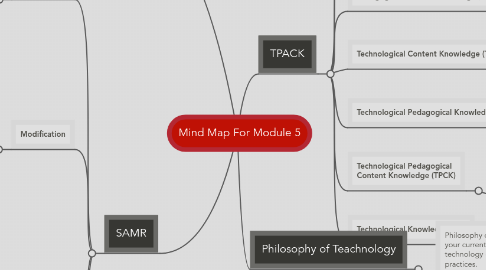
1. SAMR
1.1. Redefinition
1.1.1. Definition: Computer technology allows new ideas and tasks to form with the help of technology.
1.1.2. Example: Students were asked to work together in creating a videos that demonstrated their learning.
1.1.3. Functional Change: Students learning is being supported through technology. They are able to create something new that would not be able to be made without the internet.
1.2. Modification
1.2.1. Definition: Is the first step over the line between traditional teachings of the classroom and transforming it. Common classroom tasks are being accomplished through the use of computer technology.
1.2.2. Example: Students were asked to write and essay around a chosen theme. There essay would then be audio recorded and presented to the class to feature their ideas.
1.2.3. Functional Change: Computer Technology allows connections to be made within the classroom that may not have been possible before. It gives the ability to give peer feed back and easy rewriting
1.3. Augmentation
1.3.1. Definition: Using computer technology to become more effective in doing common projects or tasks
1.3.2. Example: Students use a Google Form to write a quiz instead of using paper and pencil
1.3.3. Functional Change: Beneficial results are being able to get direct feedback after a quiz which allows students to become more engaged in material being learned.
1.4. Substitution
1.4.1. Definition: Computer Technology is used to preform same task as was done before the use of computers.
1.4.2. Example: Printing out a work sheet, finishing it and heading it in.
1.4.3. Functional Change: There is no functional change in the learning or teaching process. There is the possibility of having times where there will be no improvement with the usage of technology. A teacher must choose an option that is more significant in guiding the students.
2. 21st Century Learner
2.1. Foundational Knowledge
2.1.1. Core content
2.1.2. Cross disciplinary knowledge
2.1.3. Information literacy
2.2. Meta Knowledge
2.2.1. Problem solving
2.2.2. Communication
2.2.3. Collaboration
2.2.4. Critical thinking
2.3. Humanistic Knowledge
2.3.1. Life/job skills
2.3.2. Ethical/emotional awareness
2.3.3. Cultural competence
3. TPACK
3.1. Content Knowledge (CK)
3.1.1. The ability to know your subject matter. Teachers need to know what content or scaffolding their students need in order to complete a task.
3.2. Pedagogical Knowledge (PK)
3.2.1. Knowledge on how students learn. Teachers must be able to evaluate their teaching techniques and how they are presenting educational material to students.
3.3. Pedagogical Content Knowledge (PCK)
3.3.1. This is a combination of pedagogy and content. Knowledge required to make a subject understandable to the students. Teachers must evaluate what makes a subject difficult and what makes it easy to learn.
3.4. Technological Content Knowledge (TCK)
3.4.1. Knowledge of how technology can be used to teach or think about content in new ways.
3.5. Technological Pedagogical Knowledge (TPK)
3.5.1. The affordances and constraints of technology as an enabler of different teaching approaches. The ability to apply pedagogical strategies for use of technologies and being able to choose a tool based on its fitness with learning.
3.6. Technological Pedagogical Content Knowledge (TPCK)
3.6.1. Understanding how technological, pedagogical and content knowledge work together in creating a well rounded learning environment.
3.7. Technological Knowledge (TK)
3.7.1. Is knowledge of the different types of technology tools that came be integrated into teaching and how to use them. This can be the usage of laptops, internet and software. Also includes the changes of these exciting technologies.
